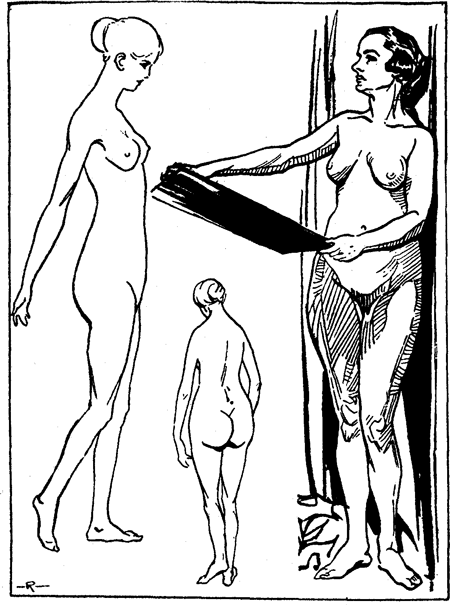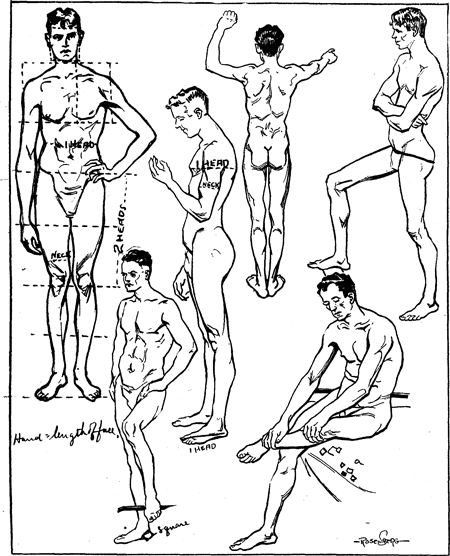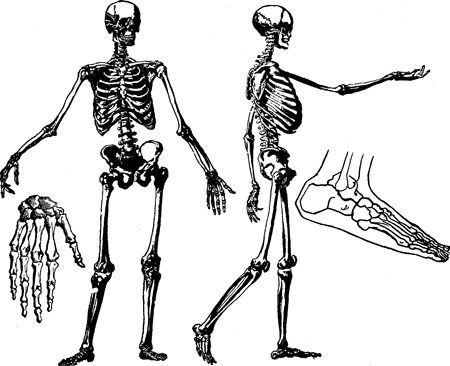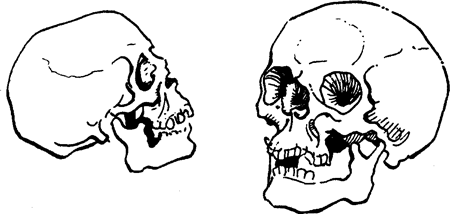Home > Directory of Drawing Lessons >How to Draw People > Human Proportions > Proportions and Measurements of the Human Body
PROPORTIONS AND MEASUREMENTS OF THE HUMAN BODY : What is the Proportion and Ratio of Women, Men, Babies and Children
|
DRAWING THE HUMAN FIGURE : PROPORTIONS AND MEASUREMENTS

Before the artist is ready to engage in practical newspaper art, he should be able to draw the human figure, and this means that he must have acquired some knowledge of anatomy. The best aid to this knowledge is sketching the nude figure from life. This does not mean that you must necessarily attend life classes. Most of the male figures in the next picture were sketched, for example, in the swimming pool of the Cincinnati Y. M. C. A. (the two lower figures in the dormitory), where I found all the people eager to pose for me.
If you live in a small town where there is no gymnasium, a good substitute is the public swimming pool. You can draw the life guards who are always standing or sitting still.
The head is your starting point. The usual male adult, including the head, is 6/2 to 7 or 7Y2 heads in height, the first proportion being the usual height. In a cartoon you will find it best to make your figures about 5 or 51/2 heads. This permits of a larger head for a better display of facial expressions.

The male figure, showing its great muscular development as compared with the female figure.

At left is a front view of the human skeleton, to the right a profile, as in action. Inset
to the left is shown the structure of the hand, a foot at right.
Always measure the figure by one standard — the length, of the subject's head, from the top of the cranium (including the hair) to the tip of the chin.
In a figure seven and a half heads in height, the second head will be at the base of the chest muscles ; the third head will reach below the navel, or slightly below the top line of the hips ; the fourth head will reach midway of the thigh; the fifth will touch the knee cap; the sixth will reach to the base of the calf muscle, and the seventh will touch the floor, at the tip of the big toe.
From temple to temple the head is equal in width to the length of the face, from the eyebrows to the chin, or two-thirds the length of the face.
Across the shoulders the average man is 1 1/2 heads wide.
The width of the chest muscles equals the length of one head.
The narrowest point in the upper body (the torso) is at the waist. This point equals the length of one head.
The longest limb of the body is the upper leg, as the bone thereof (the humerus) is the longest in the body. From the top of the hip bone to the knee cap (patella) it is two heads in length. The leg tapers down narrower and inwardly. This inward trend is markedly shown in people who are knockkneed. In that case the lower legs tend to spread apart more at the base.
In the bow-legged subjects (more common among the negroes) this is reversed. The knees do not meet—the feet do.
From the knee cap (patella) to the tip of the toes the length equals 272 heads.
From the ankle to the tip of the big toe is two-thirds the length of the head.
It is to be understood that this varies according to the position from which the artist is viewing the model. If you look down at the feet from a line horizontal with the model's shoulders, the feet will appear longer than if the drawing were made from a position on a level with the knee cap.
You should draw your model six to ten feet distant, on a horizontal line with the center of the model's figure.
The arms from shoulder to finger tips should reach no lower than the fourth head, or the center of the upper leg.
The elbow will about touch the hip.
On a back view the wrists will be on the same horizontal line with the base of the pelvic cheeks.
The wrist is the narrowest portion of the limbs.
The lower portion of the upper leg is about equal to the width of the neck.
The inside ankle bone is always higher than the outer ankle prominence.
On the profile view the widest part of the figure is the region of the chest. The outline of the chest to that of the shoulder blade (scapula) is the distance of one head.
The pit of the abdomen disappears on a horizontal line with the center of the pelvic cheeks.
The length of the foot (profile) is one head.
The hand equals the length of the face (from the top of the forehead to the tip of the chin).
The profile view of the muscle of the upper arm will about equal the neck in width, owing to the degree of perspective involved.
In standing the region of the heel forms a square protuberance. Otherwise the heel rounds at the base.
To get the pose of the nude figure, lay it out first with the simple skeleton line, so that you will be better able to follow your pose while drawing in the anatomy of the figure.

Profile and front view of the skull.
Privacy Policy .... Contact Us




